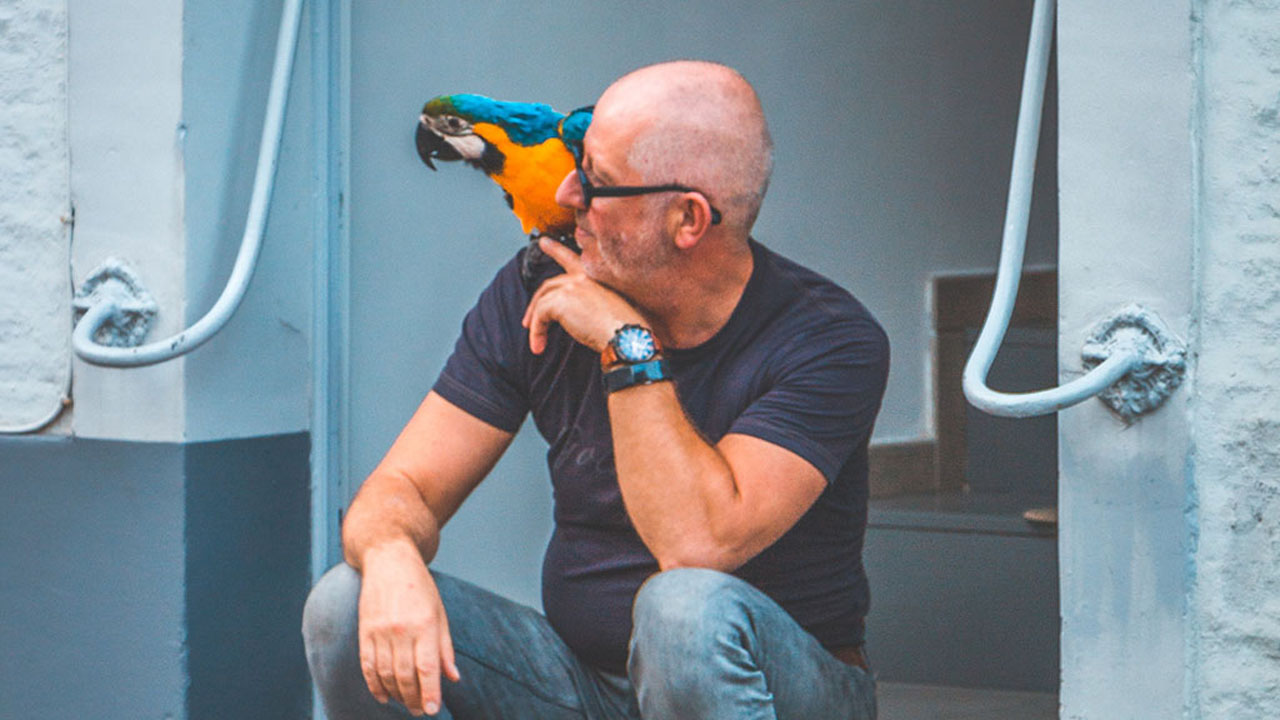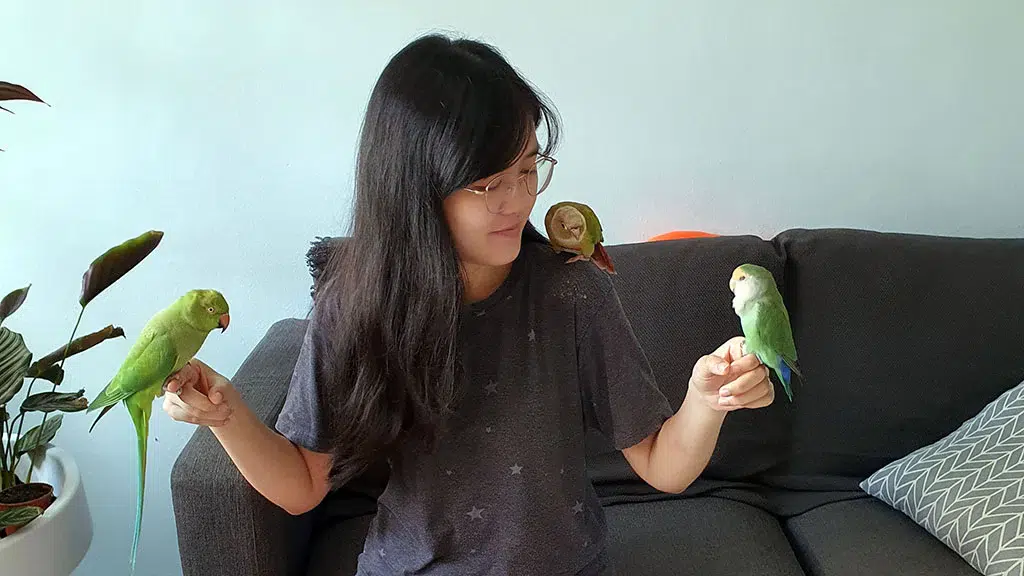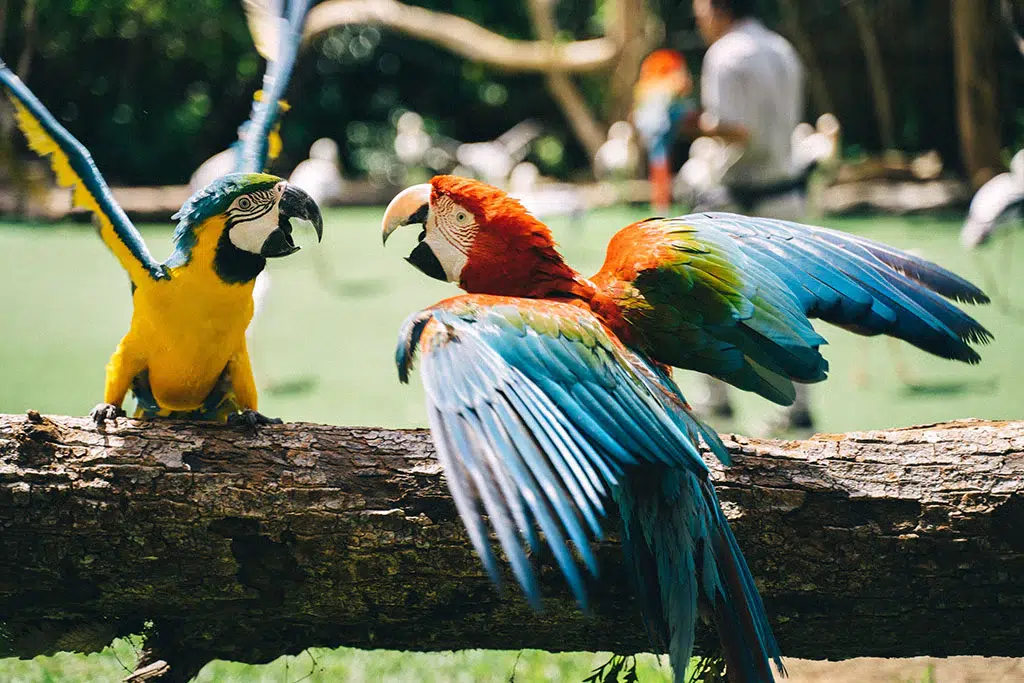
Why Does My Bird Love Sitting On My Shoulder?
Getting your first pet parrot is an exciting adventure in itself! A parrot can provide you with a world of happiness with its many tricks. One of them is their affinity towards sitting on your shoulder.
Parrots are extremely interesting creatures who are not only intelligent but also entertaining. The versatility of the parrot species makes them unique in their own ways, more so for their great range of activities. They indulge in a lot of action and gestures. One of them includes sitting on your shoulder. If you have just started to gain your parrot’s trust, you may be wondering if your parrot would like to sit on your shoulder. Personally, I have hardly seen any friendly parrot that does not want to do this – it seems to be an activity that they love!
Before diving into this act, read the sections below to learn more about allowing your bird on your shoulder, as well as what to pay attention to.
Jump To Section
Why do birds like to perch on shoulders?
Parrots may have different personalities, but one thing seems to be quite sure – they love going onto our shoulders! Truth be told, I don’t think we fully understand why parrots like to perch on our shoulders. We can only guess based on typical parrot behaviors, and extrapolate from those behaviors. Take the points below with a pinch of salt.
There may be several reasons why parrots like to sit on their owners’ shoulders. Parrots are restless creatures who are known for their curious minds. You might have already noticed that parrots only start to sit on their owners’ shoulders once they feel a bond forming. It is actually quite an interesting phenomenon, and it can be attributed to the following reasons:
It provides them a sense of home
Parrots generally live in trees, and they’re almost always standing if they are not flying. They stand on tree branches which provide them with the correct vantage point to feed their curiosity and to watch out for potential dangers. If you think about it, your shoulders are just like tree branches which make them feel close to home. It is also a comfortable posture for them that provides them with a sense of security as well.
Having your parrot on shoulder acts as the ideal place for it to rest, as it is like a tree branch. Not only can it be easily accessed, it is also wide enough for them to comfortably stand on. Parrots also feel comfortable being close to you while staying a considerable distance up from the ground.
Aligns with their social nature
Parrots are extremely social animals that generally live together in huge flocks. They perform activities as a social group and have a tendency to form an intimate bond with their owners. Hence being on your shoulder gives it the opportunity to be close to you and satiate its social needs. It helps your parrot to get your attention quickly by cuddling your face, talking in your ears, or even biting your face to get attention.
Most well-behaved parrots genuinely enjoy sitting on your shoulder. They prefer this act as it allows them to be close to their owner, who is often also their best friend. However, it is important to train your parrot well before letting them sit on your shoulder because it might indulge in bad behavior in its quest to gain your attention.
Helps them feel safe and secure
Through the stages of evolution, parrots had various predators that they had to save themselves from. One of the defense mechanisms that evolved was to sit on high branches that kept them safe from danger. This evolutionary mechanism still remains intact in domesticated parrots. This means that parrots prefer to stand somewhere higher from the ground that will allow them to be a good distance away from the source of danger.
Whenever my parrots hear a loud sound or spots an unexpected item that they perceive as dangerous, one of the first reactions is to fly to where they feel safest. These places are usually high location points in the house – on top of my fridge, on the high-hanging ropes in the bird room, or (you guessed it) my shoulders or my head!
Being on our shoulders allows them to have an ideal place to perch. Parrots choose the highest spot available to them, which also includes your head. However, since your head is moving around, your shoulders become a more stable place for them to rest.

How to shoulder train your parrot
When you take your bird home for the very first time, I would not recommend to shoulder train your parrot as the first goal. Unless the parrot is tame and already comfortable with humans before, most parrots are generally afraid and wary of new owners and environments. Immediately putting the bird on your shoulder can lead to undesirable behavior (see next section).
If the parrot is comfortable with your presence and allows you to interact with it, you can then consider to shoulder train it. One of the first steps in starting to shoulder train your bird is to first let them be comfortable stepping onto your hand.
To do this, first place your arm at a 90-degree angle (perpendicular) to the floor, keeping your elbows steadily tucked into your side. This will allow your bird to step up onto your hand without running directly to your shoulder. This simple gesture can serve as an immediate command for your bird to get on your hand. If they show resistance, you can place your bird’s favorite treat and use that to motivate them onto your hands.
The next step involves motivating your bird to move onto the opposite arm by placing the treat on the other arm and delivering them there. Birds are generally curious creatures and have high reasoning skills, which actually make the training process much easier. By doing this, you can then help them to get upon your shoulder by using such positive gestures. It is important that you only use positive vibes and no punishment during the training phase, as it can otherwise damage the bond between you and your bird.
It is also important to teach your parrot to respect your shoulder. In this, you must train your bird to only get to your shoulder when you place it there. Otherwise, it can become very difficult to control and eventually frustrating. When training your parrot, you can use verbal instructions to give them signals. Most pet owners tap on the shoulders and use the word UP to allow them onto the shoulders or the word DOWN and tap on some other surface to ask the bird to dismount.
When training your parrot, it is very important to observe their body language at all times. This is one of the most fundamental aspects of training any animal. Observing their body language allows you to understand their temperament and reactions to various situations that might arise during the training session. Birds especially express a lot through their body language, and a close observation of this will allow you to solidify your relationship with your pet. The reason why domesticated birds sometimes bite is because they are not being paid attention to properly, and their body language is not being examined right.
Is it bad to let my parrot on the shoulder?
It is also important to understand the potential risks of having your parrot on shoulder. For a parrot, sitting on your shoulder is an ideal activity as it is truly reinforcing in many ways. However, having your parrot on the shoulder is truly a hit or miss experience because you never know when you frighten or vex them, which may lead to negative consequences. Here are some problems with having your bird on your shoulder:
- Parrot screams are very loud and can cause damage to your ears if they reach a certain decibel. These animals are talkative and might scream out of excitement or anger, which can land you in potential trouble.
- When parrots bite, it is not only painful but also dangerous in many cases. With their powerful beaks, they have the potential to lacerate your skin, bite off your fingers, and can even break bones. Having them so close to your face can lead to severe damage even with a single bite.
- Before you start letting your bird sit on your shoulder, they have to be appropriately trained. An ill-trained bird does not listen to its owners, which leads to unforeseen circumstances.
- As defensive animals, parrots get spooked very easily. When on your shoulder, a sudden sound or anything out of the ordinary can lead to a frenzy of actions. They might start screaming, biting, or flapping their wings which might lead to a potential injury.
- If your parrot is already disobedient and has behavioral problems, they might worsen when they are on your shoulder.
- If you have jewelry or accessories like glasses and earrings, your parrot can tug on these objects and try to take them more forcefully, resulting in some damage. I have heard of birds removing their owners’ earrings or ear studs when perched on their shoulder. Even for myself, I no longer buy plastic-rimmed glasses because my birds love chewing on them, resulting in a very scratched, weathered pair of glasses!
- If you have a smaller bird, there also remains the risk of accidents happening while they are sitting on your shoulder. If they do not have the capability to grasp tightly, they can slide, resulting in serious injury.
When we first got Loki the lovebird, we hadn’t known the risks too well and since Loki was a fairly friendly bird that loves our shoulders, we let her go up our shoulders anytime she wanted. Once, she was on my mum’s shoulder when my mum bent over to the floor to pick something up. Loki noticed her lips were just within her reach and somehow didn’t like the look of my mum’s lips, and decided to lunge and bite! She did not let go for a few moments but for my mum it felt like an eternity! Her lower lip swelled up and bled a little after that. It was not a pleasant experience!
The Do’s and Don’ts of having your bird on your shoulder
Do:
- Let your parrot sit on your shoulder to foster bonding and closeness.
- Walk around the house with your bird on shoulder to let it watch your activities. This helps to relieve boredom.
- Allow your parrot to be on your shoulder if it is feeling uneasy – for many birds that have established a trusting bond with their owners, being close to their owners in this way is reassuring for them
Don’t:
- Avoid letting your parrot on your shoulder if you have not gained its trust yet. A wary parrot can be tricky to handle as it may find your hair, ears, or face threatening and attempt to attack you.
- Don’t allow your parrot to sit on your shoulder if you have not done other interaction training, such as the basic “step-up” yet. You will need your parrot to be comfortable with this command in order to bring your parrot down from your shoulder whenever you want. However, even trained parrots may not want to step off your shoulder sometimes! Having been trained to “step-up” would at least increase the chance that your parrot is willing to step onto your finger to be brought down.
- This is not an absolute “don’t”, but something to be mindful of: if you are wearing accessories such as earrings, necklaces, lip or nose rings, etc., many parrots may try to chew or tug at them out of curiosity. This can cause you some pain or injury. Even putting on makeup or wearing a face mask can cause your parrot to be curious, and reach out to chew or bite. If this is the case for your parrot, only allow your parrot on your shoulder when you do not have any accessories on you.
How to get a parrot off your shoulder
When you have your bird on your shoulder, it can mean various things. For one, it is a sign that your bird trusts you and you have been successful in building a bond with them. This is a behavior that they exhibit once they feel safe and secure with their owner. It means that they have been able to recognize you as a friend and is willing to be physically close to you.
When you have your parrot on your shoulder, it is generally a means for them to get your attention. It helps them to keep you in close proximity and let you know of any requirements that they might have. While there are various pros and cons of having a bird perched on the shoulder, it can become very annoying and often frustrating if the bird does not get off your shoulder even after various trials.
This happens particularly for me when it is time for my birds to go back to their cages, but they refuse to do so. When such things happen, I try a few different methods to get them off my shoulder:
- Offer them an interesting toy that is barely out of their reach. They are easily distracted and the presence of their favorite toy, or a new attractive plaything.
- Use treats to lure them off your shoulder. Only allow them to get hold of the treat if they are fully off your shoulder. Also praise them verbally!
Even if it gets very frustrating, don’t lose patience with your bird. After all, they are clinging onto your shoulder because they enjoy your company, and we can hardly fault them for that! On a regular basis, incorporate a strict training program to teach your bird how to get off your shoulder on command. It takes time to achieve it, but it is definitely not impossible!
Dominance in parrots
One of the most important features in parrots that you will start to acknowledge in due time is that they have various ways of exhibiting their dominance. This is generally a behavior exerted, especially if they need something and want a disagreement to be resolved. Parrots may show dominance when food is limited, when they want an ideal position for nesting, when they want to have more space to themselves, or when they want to perch in a spot that is otherwise occupied.

While these apply to parrots in the wild, there are some things that parrot owners have to keep in mind. In a more domestic setting, parrots can still exert that dominance over their owners by wanting their attention, rejecting food that they do not like, demanding specific foods that they do enjoy, not letting other people or pets around their owner, screaming and showing aggression for attention, or by making sure that others that stay away from their cage.
You might be wondering how their dominance has anything to do with having your parrot on your shoulder. Some people believed that their dominant nature could be tied to a phenomenon in parrots called height dominance. In the wild, often, the taller or bigger animal is considered superior.
Keeping this in mind, people previously believed that parrots should not be allowed on shoulders as it might have a negative effect on a parrot’s natural instinct towards dominance. However, this has been debunked and is now considered a fable and non-existent in parrots. While parrots do fight and often show aggressive behavior in the wild within the same flock, height dominance has never been noted. Mammalian social hierarchy cannot be equated with those that exist in parrots.
Can I take my bird outdoors while perched on my shoulder?
When you have your bird perched on your shoulder, it is truly a magical feeling being so close to your pet. Once you have formed a bond with your bird, you might feel safe enough to take them outside. However, having trained them in the confines of your house, you cannot possibly imagine the risks of taking your bird outside while it is sitting on your shoulder.
Parrots are generally prey animals. They are wired to stay vigilant at all times and are easily startled by sudden movements or a loud noise. Their first instinct is to either brace and fight, or fly away from the source of distress. If you take your bird outside while it is sitting on your shoulder and it get startled by anything, you can lose your bird immediately. Even if you have built a strong bond of trust and loyalty, you cannot fight with their natural instincts to flee. Birds are lost every year from their owners because of such incidents.
Even if you have taken all the time to train your bird efficiently, you cannot guarantee its safety once you take it outside your house. Even if its wings are clipped, it will still fly considerably. Hence you must never take your bird perched on shoulder unless you are using a bird harness or taking the pet out in a carrier.
Freya flew away once! And I never risked it again
Here is a video that I took of Freya when she was younger, and her wings were still clipped. I had not realised that her flight feathers were starting to grow back out and it was sufficient to keep her in the air for a certain amount of time, should she decide to fly. I often took her out on my shoulder when her wings were still clipped and she would stay there quietly. Even moving cars and passing bicycles did not faze her. However, in this particular incident, she was terrified of the exercise machines and I hadn’t noticed it. I was taking a video of her enjoying the outdoors when she decided to squawk and fly away.
Two things came into play here:
- When she flew out of my hand at home, she always glided downwards due to her clipped feathers. She had hardly managed to fly upwards. Even outdoors on this particular day, she had tried to fly off from my shoulders for fun, but had always glided toward the floor, never upwards. I thought she was safe. However, in this situation, the threat of the exercise machines led to her expending all the strength she had in her to fly as far away as she could possibly manage.
- She was on my hand, which was meant that her starting position was at a certain height, and not on the ground. If her starting point was on the ground, she might not have had the ability to fly up a tree, but starting higher enabled her to do so.
Fortunately, she did not fly further away but stayed perched on a short tree. We managed to lure her to a lower point in the tree and made use of a long fallen branch to get her to step up on, and she came back down to us. I definitely made sure to hug her all the way back home on that day!
No matter how much you trust your parrot to stay with you all the time, you can never be prepared enough for unexpected triggers in the environment which could lead to your parrot flying away when perched on your shoulder. This is something I don’t recommend to bird owners to do.
Final notes
So, now you know the basics of having a bird on your shoulder. Understanding why they like to sit on your shoulder and the various pros and cons is a fundamental step in building a proper relationship with your pet. Once trained, you will be able to guide your bird up and down your shoulder in no time at all. Here are a few of the crucial things to keep in mind:
- Birds generally sit on shoulders to get a good vantage point, to be in your close proximity, to feel at home, and for a feeling of security.
- Having your bird on your shoulder comes with some risks, and you must understand these aspects when training your bird.
- Training your bird is a step-by-step process that enhances mutual trust and must be done with care following the right steps.
Parrots can provide you with the most beautiful company if you know how to handle them. There is nothing to worry about as they are extremely intuitive creatures with whom you can form a sensible bond. Take time and be patient in the journey, and you will have a friend for life!
Parrot Junkie www.parrotjunkie.com
Copyright © 2021-2024. All rights reserved.



Be the first to leave a comment